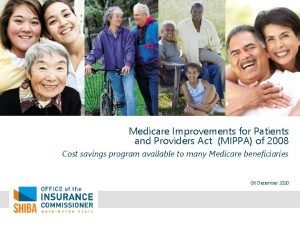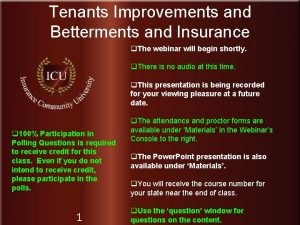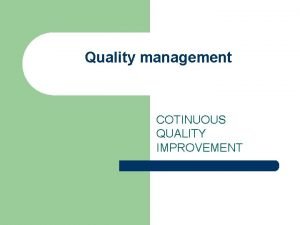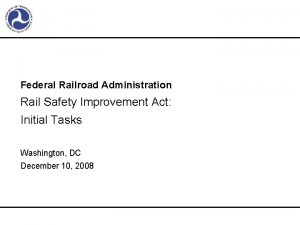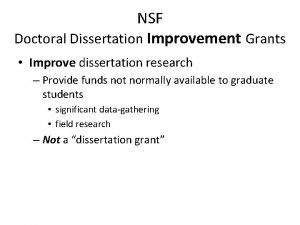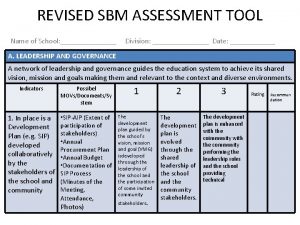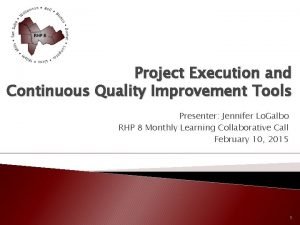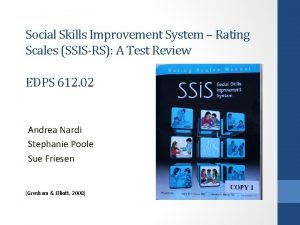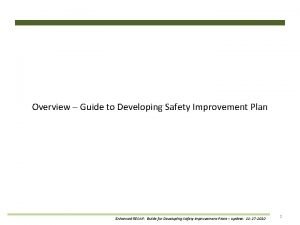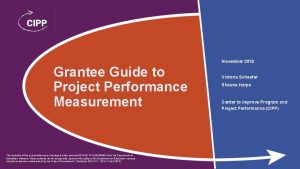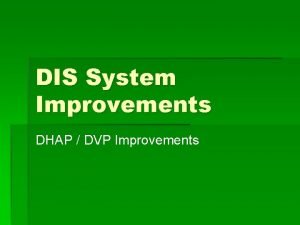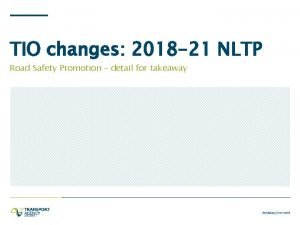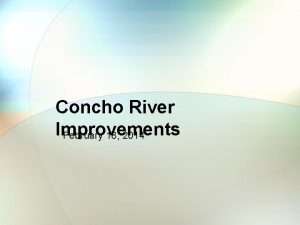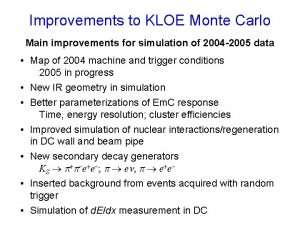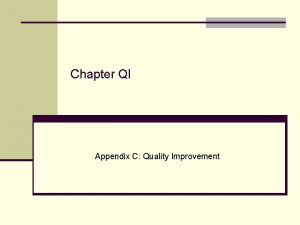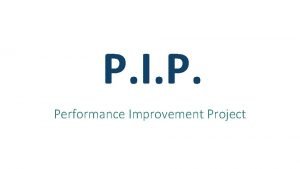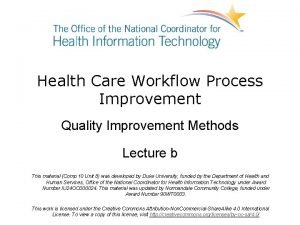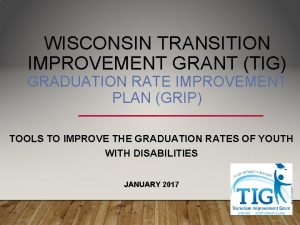201821 NLTP Improvements Overview of Improvements A Improvement
















- Slides: 16

2018/21 NLTP - Improvements

Overview of Improvements • A Improvement activity is a stand alone activity that leads to an improvement: • The activity addresses a gap in Customer Levels of Service (CLo. S) • The activity improves efficiency of the land transport system in delivering existing CLo. S • Activities include but are not limited to State Highway improvements, Local road improvements, Regional improvements, Resilience improvements (used to be preventive maintenance), Walking and cycling improvements, Public transport improvements

Moderation process The moderation process aims to provide a consistent national view across all proposals within activity classes and ensuring that investment levels are consistent with the GPS priorities. The moderation process aims to: • Provide you with a better understanding of why and how we make investment decisions • Ensure the clarity and transparency principles are embedded in the way we work* • Deliver a prioritised programme of work relating to improvement activities through the NLTP

Conditions for funding improvements All the following conditions must be met when an improvement proposal is submitted for funding approval during the NLTP period: • An activity will be considered for funding if it is already included in the NLTP • As long as there is funding available in the appropriate activity class • At the time the funding request is made the improvement is supported by a robust business case* • The investment partner demonstrates their readiness and ability to deliver the improvement

Results Alignment • For the 2018 -21 NLTP, the results alignment rating will be used by the Transport Agency to assess the significance of a problem, issue or opportunity relative to desired results set out in the GPS • The rating assessment is not an indication of how well a programme or activity is being optimised and delivered by an organisation • By default, the results alignment rating for Improvement Activities is low • A medium result alignment rating indicates that a network or issue being managed will largely meet the appropriate customer levels of service

Customer Levels of Service • The Transport Agency recognises that customer levels of service measures are not fully developed for all activities • In the case of road improvements, the One Network Road Classification (ONRC) has been adopted by the sector to ensure national consistency in the levels of service delivered by a network across the classification hierarchy • For safety levels of service the Transport Agency adopts a thresholds for medium and high safety risk derived from Safer Journeys areas of concern • For public transport and walking and cycling no nationally consistent level of service or classification exists

Cost & Benefit Appraisal • Improvement Activities are given a rating in bands for cost benefit appraisal based on their benefit-cost ratios* • BCRs incorporate whole-of-life costs and benefits • BCRs are in the following bands: • below 1 • between 1 and 2. 9 • between 3 and 4. 9 • between 5 and 9. 9 • 10 or above • Project level funding approvals will be made on the basis of the calculated BCR rather than the bands • At the programme business case phase, bands provide sufficient basis for prioritisation given the uncertainty around the high level costs and benefits

TIO changes at a glance? We use TIO to capture and manage investment proposals and the templates have been designed to incorporate investment partner feedback to achieve the following; • Assessment of Business Case (ABC) module added • Redundant fields removed • Better inheritance • Support for benefit reporting and management • Greater transparency • Explicit recording of decision documents (by NZTA) • “Snapshots” part of transparency measures • Greater level of in-built guidance

TIO – Business Case Approach (BCA) • TIO reflects the 16 questions used in the assessment of robustness of application of the BCA • The 16 questions address: • Strategic case stage (8) • Programme business case (4) • Implementation approval (4) • The business case is assessed as pass/rework/fail at a question and proposal level • The outcome of the assessment of individual questions will inform and influence the overall pass, rework or fail of the investment proposal

TIO - Inheritance • Inheritance in respect to TIO is when specific information will prepopulate certain fields based on an the initial input of information - the details will feed through to subsequent phases of the proposal development in TIO* • When a strategic case is reviewed the changes must be entered through strategic case screen • BCR is not inherited from Programme Business Case stage so this information will be re-calculated at each proposal phase**

TIO - Strategic case module • In most cases this will be the first time information is entered into TIO for the improvement proposal • The Transport Agency assess the merits of the strategic case based on the information provide by the investment partner* • The information entered at this point will feeds through to subsequent stages** • This information input is mandatory requirement for all activities • The strategic case can be used as a reference point for one or more activities – this is very useful to see the relationship across activities

TIO - Benefits capture • Within TIO there is a Cost Benefit Appraisal screen where benefit and cost information is captured * • Data is prepopulated in TIO if the input templates are used** - simplified procedures • All data is consolidated in the summary EEM worksheet** • The information that is captured at this time will be used in benefit and outcomes reporting - All of which aims to increases transparency of decision-making

TIO - Resilience Improvements • These types of improvements have been reassigned from maintenance programmes • The strategic case in most case will still be an Activity Management Plan • The assessment requirements for improvements will apply and use the same TIO improvements template

TIO - Very high rating • The rating will appear in TIO based on the following * • An improvement activity can achieve a very high results alignment rating it addresses one of the key GPS results areas** • Improvement activities have a very high cost benefit appraisal rating if the BCR is 10+ • A proposal may still be considered eligible if either results alignment or BCR are below the minimum threshold

TIO – Information snapshots • TIO will make a recording of submitted information at each approval phase • This information will show a comparative view through life of the improvement activity • By baselining the improvement activity, users will be able to view cost, scope and time adjustments • The ability to view the snapshot functionality is accessible through the activity record*

Supporting Information For further information please refer to the following sources of information: • Investment Decision Making Website http: //www. nzta. govt. nz/planning-andinvestment/planning/201821 -national-land-transportprogramme/investment-decision-making • PIKB - https: //www. pikb. co. nz/ • Or contact your Local Regional Investment Advisor
 Medicare improvements for patients and providers act
Medicare improvements for patients and providers act Offsite improvements
Offsite improvements Improvements and betterments insurance
Improvements and betterments insurance Improvements roadmap
Improvements roadmap Pughs tires
Pughs tires Direct improvements
Direct improvements Www svcfin com make a payment
Www svcfin com make a payment Cotinuous
Cotinuous Rail safety improvement act of 2008
Rail safety improvement act of 2008 Nsf doctoral dissertation improvement grant
Nsf doctoral dissertation improvement grant Revised sbm assessment tool
Revised sbm assessment tool Continuous quality improvement plan example
Continuous quality improvement plan example Social skills improvement system scoring
Social skills improvement system scoring Safety improvement plan
Safety improvement plan Crop improvement in biotechnology
Crop improvement in biotechnology Performance improvement plan examples
Performance improvement plan examples Call center performance improvement plan template
Call center performance improvement plan template
